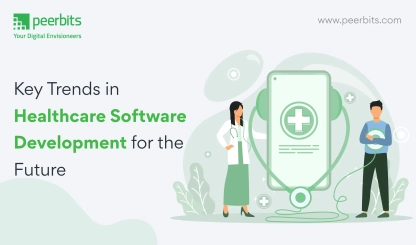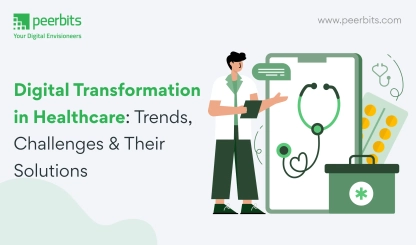According to the report of Global Market Insights, the telemedicine market was valued at over USD 71.5 billion in the year 2022 and will depict a CAGR of over 12.5% over the forecast year 2023-2032. It indicates the growth and potential of telemedicine in the healthcare industry.

Telemedicine has become increasingly important in recent years, as it provides a convenient and efficient solution for individuals living in remote or underserved areas, where access to healthcare is limited.
Additionally, it also allows for more flexibility in scheduling appointments and reduces the need for patients to travel to see a healthcare provider.
Whether you are a developer or an entrepreneur, this guide will provide an in-depth look at the process of telemedicine app development - that can benefit patients, healthcare providers, and insurance companies. From initial planning to final deployment, we will cover each step of the development process.
Without any more addon; let’s begin.
Research and Analysis
A critical step in the telemedicine app development process is determining the target audience's specific needs and requirements. This phase allows the team to collect crucial information, understand market trends, and tailor the app to meet the needs of the target audience, ensuring its market competitiveness.

Identifying the target audience and their needs
This step involves understanding the demographics of the patients that will be using the app and what their needs are.
For example, is the app targeting elderly patients who may have difficulty using technology? Or is it targeting patients with chronic conditions who need regular monitoring?
Understanding the target audience will help to ensure that the app is tailored to meet their specific needs. This can be done by conducting surveys, focus groups, or interviews with potential users.
Analyzing competitors and market trends
Researching existing telemedicine apps in the market and identifying their key features, pricing, and user feedback is an important step in developing a telemedicine app.
Understanding what is already available allows the team to identify market gaps and create a unique value proposition for the app under development. This can be accomplished by conducting extensive market research and identifying key industry players.
This will help to ensure that the app is market competitive and has unique features that set it apart from others.
Defining the app's features and functionalities
The team will define the app's specific features and functionalities based on research and analysis of the target audience and market. This will include video consultations, messaging capabilities, and the ability to view medical records.
This step also includes creating a roadmap of the features and functionalities that will be implemented in each phase of the mobile app development.
Understanding the technical requirements and regulations for telemedicine app development
Telemedicine is heavily regulated, so it is critical to understand the legal and technical requirements that must be met. HIPAA compliance, data security, and privacy regulations are all part of this.
This step also includes identifying the technology stack and infrastructure that will be used to develop the app and ensuring that they comply with the regulations.
The team will be able to develop an app that is tailored to meet the needs of the target audience, is competitive in the market, and complies with all necessary regulations by conducting extensive research and analysis.
Design and User Experience
Emphasizing designing an interface that is simple and user-friendly for the telemedicine app is essential. This step is critical in making the app visually attractive and simple to use for patients, which will enhance the chances of it being accepted and utilized.

To achieve this, it is important to hire mobile app developers who have a track record of designing visually attractive and user-friendly interfaces.
Read more: App Usability and Its Role in Delivering the Best User Experience
Creating wireframes and user flow diagrams
Wireframes are simple visual representations of the app's layout and functionality, whereas user flow diagrams depict the various steps a user will take while using the app. These tools will assist the team in planning the app's overall structure and functionality. Prototyping the app to see how it will look and feel is also part of this step.
Designing the user interface and user experience
This step involves creating a visually appealing and easy-to-use interface for the app. This will include things like color schemes, typography, and iconography. The team will also focus on making the app easy to navigate and understand so that patients can easily find the information and services they need.
This step also includes testing the app with users to see how easy it is to use, gather feedback and make necessary adjustments.
Incorporating necessary security and privacy features
This phase focuses on incorporating security and privacy measures into the app to guarantee the protection of patient information.
This includes features such as encrypted messaging, password protection, and data encryption. Additionally, it involves designing the app's navigation to guide users to the secure and private sections of the app.
Conducting user testing and gathering feedback
This step involves testing the app with a group of users and gathering feedback on their experience. This will help the team to identify any issues with the app and make any necessary adjustments before it is released.
This phase also includes testing the app on different devices and platforms, to ensure that it works seamlessly on all of them.
Development and Implementation
Emphasis on constructing the technical infrastructure and features of the telemedicine app is vital. This step is essential in making sure that the app is reliable, secure, and complies with the requirements established in the research and analysis phase.
Partnering with healthcare app development companies can assist in the development and implementation of the telemedicine app.

Choosing the appropriate technology stack
This phase concentrates on selecting the appropriate programming languages, frameworks, and tools for building the app. The team must take into account factors such as scalability, performance, and security when selecting the technology stack.
Furthermore, it includes identifying the hosting providers, database providers, and other necessary technologies that will be used to construct the app.
Read more: Tips to pick the best technology stack for your product
Building the app's backend and infrastructure
This step involves creating the server-side of the app, including the database and APIs. The team will need to ensure that the backend is scalable and can handle the expected number of users and transactions. This phase also includes creating the database schema, designing the APIs and building the server-side logic.
Implementing the app's features and functionalities
This phase focuses on incorporating the features and functionality specified in the research and analysis phase. This includes elements such as video consultations, messaging functionality, and the capability to view medical records. The team will also need to guarantee that the app can handle high traffic and data storage needs.
Ensuring compliance with telemedicine regulations and standards
This phase is dedicated to ensuring that the telemedicine app adheres to all relevant regulations and standards. This includes compliance with HIPAA, data security, and privacy laws.
The team will also implement robust security protocols and thoroughly test and validate the app's adherence to these regulations to ensure a secure and compliant telemedicine experience for users.
Deployment and Maintenance
This phase focuses on ensuring the availability and sustainability of the telemedicine app for patients by deploying it and maintaining its performance over time. It's critical to ensure that patients have access to the app and it can handle the expected number of users and transactions.

Deploying the app to app stores and the web
This step involves making the app available for download on app stores such as the Apple App Store and Google Play, as well as deploying it on a website for web access. This includes submitting the app to the app stores, getting it approved, and making it live for the users to download.
Setting up analytics and monitoring systems
This phase centers on establishing systems that enable the team to track the usage and performance of the app. This includes monitoring user engagement, detecting any issues or errors within the app, and identifying areas that need enhancement.
Additionally, it involves implementing monitoring tools and analytics, to gain insights into the app's usage, performance, and user behavior.
Providing ongoing maintenance and updates
This step involves providing regular updates and maintenance for the app to fix bugs, add new features, and keep the app running smoothly. This phase also includes creating a maintenance plan and a schedule for updates and fixing any issues that users may face.
Addressing user feedback and addressing bugs
This step involves monitoring feedback from users and addressing any issues or bugs that are identified. This step also includes creating a support system, a process to handle user feedback, and addressing any issues and bugs that are reported by the users.
Conclusion
Developing a telemedicine app is a complex process that requires careful planning, research, and execution. By following the steps outlined in this guide, you can develop a telemedicine app that meets the needs of the target audience and is competitive in the market.
The guide covers all the important aspects of telemedicine app development, starting with research and analysis to identify the target audience and understand their needs, and the market trends.
If you're in need of a telemedicine app, look no further.
At Peerbits, we specialize in creating custom telemedicine apps that meet the specific needs of clients. Our team of experienced developers are proficient in the latest technologies and have a proven track record of delivering high-quality, user-friendly, and feature-rich apps.
Trust Peerbits to bring your telemedicine app ideas to reality and meet your business needs.




